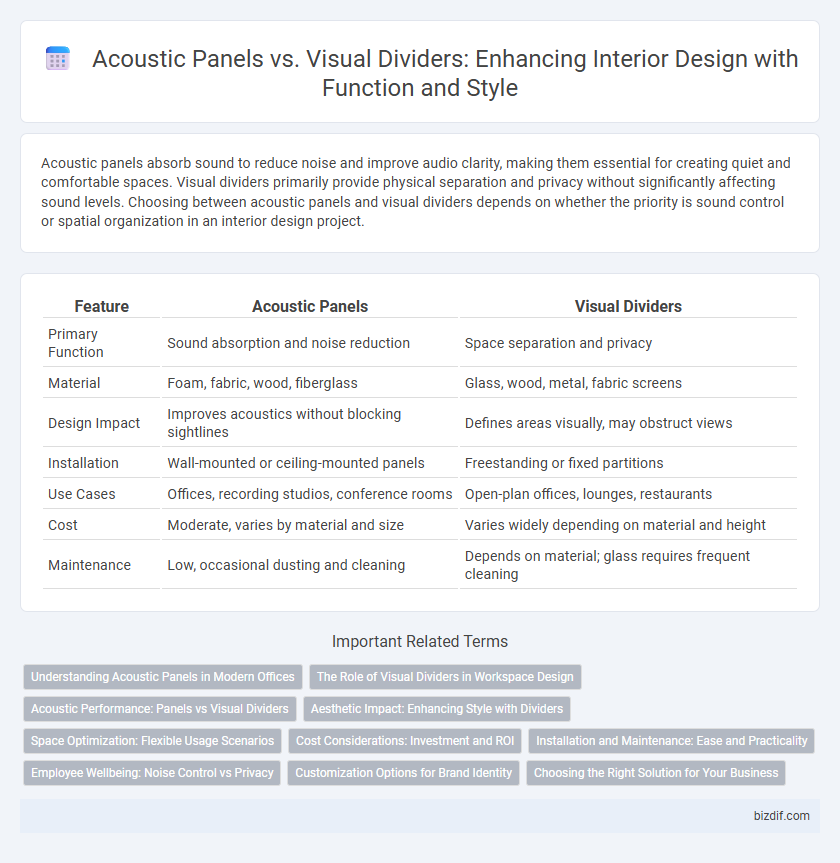Acoustic panels absorb sound to reduce noise and improve audio clarity, making them essential for creating quiet and comfortable spaces. Visual dividers primarily provide physical separation and privacy without significantly affecting sound levels. Choosing between acoustic panels and visual dividers depends on whether the priority is sound control or spatial organization in an interior design project.
Table of Comparison
| Feature | Acoustic Panels | Visual Dividers |
|---|---|---|
| Primary Function | Sound absorption and noise reduction | Space separation and privacy |
| Material | Foam, fabric, wood, fiberglass | Glass, wood, metal, fabric screens |
| Design Impact | Improves acoustics without blocking sightlines | Defines areas visually, may obstruct views |
| Installation | Wall-mounted or ceiling-mounted panels | Freestanding or fixed partitions |
| Use Cases | Offices, recording studios, conference rooms | Open-plan offices, lounges, restaurants |
| Cost | Moderate, varies by material and size | Varies widely depending on material and height |
| Maintenance | Low, occasional dusting and cleaning | Depends on material; glass requires frequent cleaning |
Understanding Acoustic Panels in Modern Offices
Acoustic panels in modern offices are designed to absorb sound, reduce noise pollution, and improve speech clarity, enhancing overall productivity and comfort. Unlike visual dividers, which primarily separate spaces visually without significant sound control, acoustic panels utilize materials such as foam, fabric, or perforated wood to minimize reverberation and echo. Incorporating acoustic panels effectively addresses sound management challenges in open-plan offices, contributing to a quieter and more focused work environment.
The Role of Visual Dividers in Workspace Design
Visual dividers play a crucial role in workspace design by defining zones without obstructing light or airflow, unlike traditional acoustic panels that primarily target sound absorption. These dividers enhance privacy and organization while maintaining an open environment, contributing to employee well-being and productivity. Incorporating materials that balance transparency and opacity allows visual dividers to complement aesthetic preferences and functional requirements effectively.
Acoustic Performance: Panels vs Visual Dividers
Acoustic panels are engineered to absorb sound waves, significantly reducing noise levels and enhancing speech clarity in a space, whereas visual dividers primarily serve as physical barriers with minimal impact on sound absorption. Materials such as mineral wool or foam used in acoustic panels achieve high Noise Reduction Coefficient (NRC) ratings, often above 0.7, indicating superior sound dampening capabilities. Visual dividers, typically made from glass or lightweight materials, offer limited acoustic performance, making them less effective in controlling reverberation and ambient noise.
Aesthetic Impact: Enhancing Style with Dividers
Acoustic panels enhance aesthetic impact by combining sound absorption with sleek, modern designs that complement interior decor, transforming noisy spaces into tranquil environments. Visual dividers create dynamic spatial separation while contributing bold, sculptural elements that elevate the overall style and ambiance of a room. Both options offer customizable textures, colors, and materials, allowing designers to seamlessly integrate functionality with artistic expression.
Space Optimization: Flexible Usage Scenarios
Acoustic panels enhance space optimization by reducing noise and improving sound quality without compromising open layouts, making them ideal for collaborative workspaces or quiet zones. Visual dividers offer flexible spatial segmentation, creating defined areas for privacy or focused tasks while maintaining visual connectivity. Combining acoustic panels with visual dividers allows multifunctional spaces to adapt dynamically, optimizing both sound control and spatial organization.
Cost Considerations: Investment and ROI
Acoustic panels typically require a higher upfront investment than visual dividers due to specialized materials and installation, but their ability to improve sound quality can significantly boost workplace productivity and overall comfort, offering strong ROI. Visual dividers are generally more affordable and easier to install, making them a cost-effective choice for basic space separation without addressing noise issues. Careful evaluation of the investment against long-term benefits, such as employee well-being and reduced distractions, determines the most economically viable option for interior design projects.
Installation and Maintenance: Ease and Practicality
Acoustic panels offer straightforward installation with options like adhesive backing or mounting brackets, requiring minimal tools and time, while visual dividers often involve more complex assembly or heavy materials that demand careful handling. Maintenance for acoustic panels typically involves dusting and occasional vacuuming to preserve sound absorption, whereas visual dividers may need regular cleaning of fabric or glass surfaces to maintain aesthetic appeal. The ease of installation and low upkeep of acoustic panels make them a practical choice for enhancing sound quality without extensive effort.
Employee Wellbeing: Noise Control vs Privacy
Acoustic panels enhance employee wellbeing by effectively reducing noise levels, minimizing distractions, and promoting concentration in open office environments. Visual dividers prioritize privacy by creating personal spaces, which help employees feel secure and focused but provide limited sound insulation. Balancing acoustic panels for noise control with visual dividers for privacy optimizes overall workplace comfort and productivity.
Customization Options for Brand Identity
Acoustic panels offer extensive customization options, including branded colors, logos, and varied textures that enhance sound control while reinforcing brand identity. Visual dividers provide flexible designs with customizable materials and finishes, allowing businesses to create distinct spaces that reflect their unique style. Both solutions integrate seamlessly into interior design, balancing functionality with personalized branding elements.
Choosing the Right Solution for Your Business
Acoustic panels enhance sound quality by absorbing noise and reducing echo, making them ideal for open office plans or conference rooms where clear communication is essential. Visual dividers create privacy and organize space without significant impact on acoustics, suitable for areas needing separation without sound control. Assessing your business needs for noise management and spatial arrangement will guide choosing the right solution to improve productivity and comfort.
Acoustic panels vs Visual dividers Infographic

 bizdif.com
bizdif.com